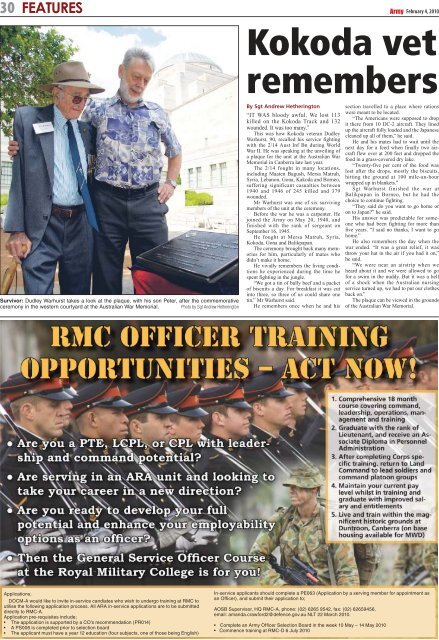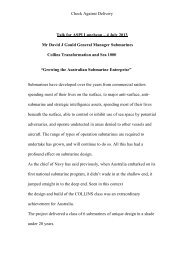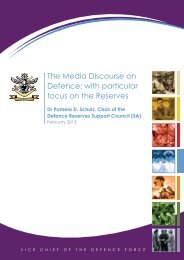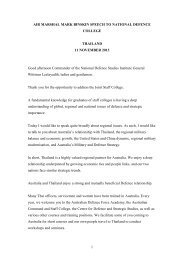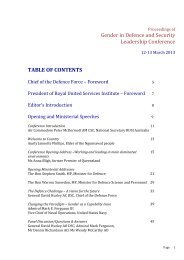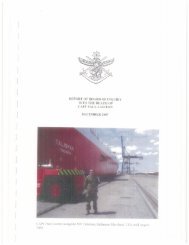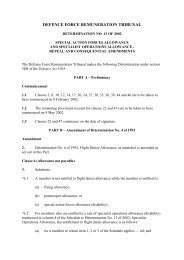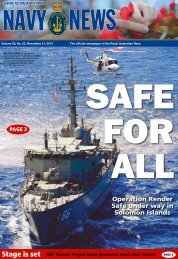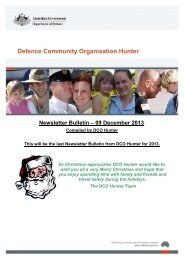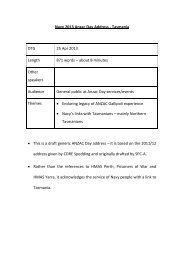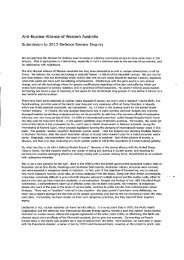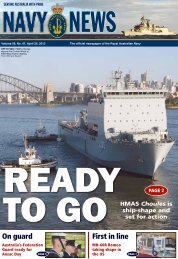right royal visit p2 7 bde's grand send - Department of Defence
right royal visit p2 7 bde's grand send - Department of Defence
right royal visit p2 7 bde's grand send - Department of Defence
You also want an ePaper? Increase the reach of your titles
YUMPU automatically turns print PDFs into web optimized ePapers that Google loves.
30 FEATURES Army February 4, 2010<br />
Survivor: Dudley Warhurst takes a look at the plaque, with his son Peter, after the commemorative<br />
ceremony in the western courtyard at the Australian War Memorial. Photo by Sgt Andrew Hetherington<br />
Applications;<br />
DOCM-A would like to invite in-service candiates who wish to undergo training at RMC to<br />
utilise the following application process. All ARA in-service applications are to be submitted<br />
directly to RMC-A.<br />
Application pre-requisites include;<br />
The application is supported by a CO’s recommendation (PR014)<br />
A PS006 is completed prior to selection board<br />
The applicant must have a year 12 education (four subjects, one <strong>of</strong> those being English)<br />
Kokoda vet<br />
remembers<br />
By Sgt Andrew Hetherington<br />
“IT WAS bloody awful. We lost 113<br />
killed on the Kokoda Track and 132<br />
wounded. It was too many.”<br />
This was how Kokoda veteran Dudley<br />
Warhurst, 90, recalled his service fighting<br />
with the 2/14 Aust Inf Bn during World<br />
War II. He was speaking at the unveiling <strong>of</strong><br />
a plaque for the unit at the Australian War<br />
Memorial in Canberra late last year.<br />
The 2/14 fought in many locations,<br />
including Maaten Bagush, Mersa Matruh,<br />
Syria, Lebanon, Gona, Kakoda and Borneo,<br />
suffering significant casualties between<br />
1940 and 1946 <strong>of</strong> 245 killed and 379<br />
wounded.<br />
Mr Warhurst was one <strong>of</strong> six surviving<br />
members <strong>of</strong> the unit at the ceremony.<br />
Before the war he was a carpenter. He<br />
joined the Army on May 20, 1940, and<br />
finished with the rank <strong>of</strong> sergeant on<br />
September 16, 1945.<br />
He fought at Mersa Matruh, Syria,<br />
Kokoda, Gona and Balikpapan.<br />
The ceremony brought back many memories<br />
for him, particularly <strong>of</strong> mates who<br />
didn’t make it home.<br />
He vividly remembers the living conditions<br />
he experienced during the time he<br />
spent fighting in the jungle.<br />
“We got a tin <strong>of</strong> bully beef and a packet<br />
<strong>of</strong> biscuits a day. For breakfast it was cut<br />
into three, so three <strong>of</strong> us could share one<br />
tin,” Mr Warhurst said.<br />
He remembers once when he and his<br />
In-service applicants should complete a PE063 (Application by a serving member for appointment as<br />
an Offi cer), and submit their application to;<br />
AOSB Supervisor, HQ RMC-A, phone: (02) 6265 9542, fax: (02) 62659456,<br />
email: amanda.crawford2@defence.gov.au NLT 22 March 2010.<br />
Complete an Army Offi cer Selection Board in the week 10 May – 14 May 2010<br />
Commence training at RMC-D 6 July 2010<br />
section travelled to a place where rations<br />
were meant to be located.<br />
“The Americans were supposed to drop<br />
it there from 10 DC-2 aircraft. They lined<br />
up the aircraft fully loaded and the Japanese<br />
cleaned up all <strong>of</strong> them,” he said.<br />
He and his mates had to wait until the<br />
next day for a feed when finally two aircraft<br />
flew over at 200 feet and dropped the<br />
food in a grass-covered dry lake.<br />
“Twenty-five per cent <strong>of</strong> the food was<br />
lost after the drops, mostly the biscuits,<br />
hitting the ground at 100 mile-an-hour<br />
wrapped up in blankets.”<br />
Sgt Warhurst finished the war at<br />
Balikpapan in Borneo, but he had the<br />
choice to continue fighting.<br />
“They said do you want to go home or<br />
on to Japan?” he said.<br />
His answer was predictable for someone<br />
who had been fighting for more than<br />
five years. “I said no thanks, I want to go<br />
home.”<br />
He also remembers the day when the<br />
war ended. “It was a great relief, it was<br />
throw your hat in the air if you had it on,”<br />
he said.<br />
“We were near an airstrip when we<br />
heard about it and we were allowed to go<br />
for a swim in the nuddy. But it was a hell<br />
<strong>of</strong> a shock when the Australian nursing<br />
service turned up, we had to put our clothes<br />
back on.”<br />
The plaque can be viewed in the grounds<br />
<strong>of</strong> the Australian War Memorial.


